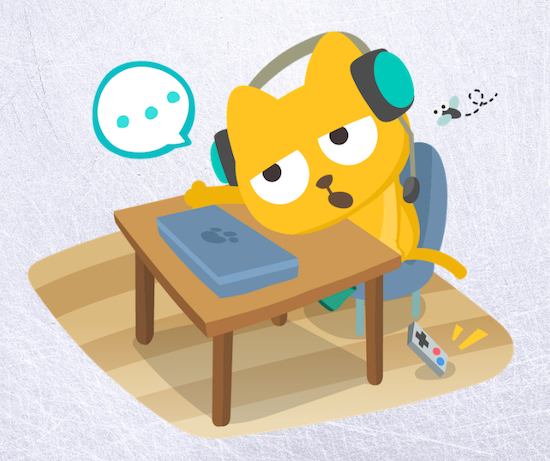Keeping Students Engaged

Learning engagement: it’s a term we all know, love, and occasionally fear. The pressure to keep students engaged in our classrooms is ever-present. For many of us, it feels like more of a challenge with each passing year.
And with so much disruption going on in education now, keeping students engaged can seem next to impossible.
But there’s no escaping it: when students are checked out, learning stops.
There are many ways that teachers attempt to keep students engaged: they ask tons of questions, create complex, interesting lessons, offer a variety of activities, and even alter their teaching style in the hopes of entertaining their students.
For some teachers, the expectation to keep students constantly engaged feels like more of a “dog and pony show” than actual teaching—which may be contributing to teacher burnout.
The trouble is, keeping students engaged is directly linked to how successful they can ultimately be in school. So, if we’re all spending so much time coming up with new, interesting ways to teach the content that students need to learn, how can we be sure that it’s actually helping to keep them engaged?
To answer this, we must first understand what engagement really is—and what we can do to make sure it’s happening in our classrooms.
What is engagement?
To understand what engagement might look like in the classroom, let’s consider two hypothetical students:
- In one fourth grade classroom, a student sits up straight in his desk, facing the teacher at the front of the room. He is quiet, and appears to be listening intently; a pencil is poised in his hand, ready to take notes on the lesson.
- Down the hall, another fourth grader in a different class jokes with his friends as they construct a project together on the floor. Their supplies are scattered around them, and their conversation is noisy (and occasionally strays off-topic).
Which of these students is actively engaged, and which is not?
For many of us, the automatic assumption is that the first student is more engaged. He’s quiet. He is listening, he is doing what he is “supposed to” and he is ready to take notes. But what we fail to realize is that these are all signs of attention, rather than engagement.
Engagement goes beyond attention, and beyond even interest—true, active engagement happens only when students are meaningfully involved with their own learning.
The other student could be equally engaged; we don’t know how immersed he is in the project, or how meaningful it is to him. It could be that the social aspect of the assignment is highly motivating for him, and so he is more engaged with it than he would be otherwise.
So how do we know if our students are truly, actively engaged with their learning?
It may be impossible to know with certainty, but there are some clues that can help us get a better idea of which lessons are reaching students on a personal level, and which may be falling flat.
Connection
I’ve always been a firm believer that building a strong classroom community is the first step to a successful year. As it turns out, science is here to back me up!

When people feel well-cared for, connected, befriended, and trusted, it boosts the neurotransmitter oxytocin, which primes the brain to learn. A sense of belonging in the classroom, and a genuine social connection to their teacher and classmates, can create an ideal learning environment for students.
On the other hand, if students have a strained or weak relationship to their teachers or classmates, it can create a stress response instead. The brain then goes into overdrive, creating glutamate and cortisol—hormones that effectively cloud the neurons necessary to think and learn, and hinder the ability to recall information.
Connection in the Classroom:
To help boost your students’ oxytocin levels, you can actively create a social environment where they feel a sense of purpose and belonging.
Give students ample opportunities to make genuine social connections with you and their classmates. Spend time getting to know your students, and in developing a meaningful relationship with them. Time spent socializing is not time wasted—it’s time invested in a group of well-connected learners!
Ask yourself:
- How are my relationships with my students? Do we all have mutual trust and respect for each other?
- Do all students feel like they belong in this class? Does each student have specific roles or responsibilities that are meaningful to the class as a whole?
- How are my students’ relationships outside of class (with family, friends, etc.)?
- Is anything about this lesson likely to cause stress or anxiety for students (i.e. singling someone out, public speaking, etc.)? And if so, how can I help them to prepare for it?
Meaning and Relevance
For students to be engaged with their learning, they need to feel that it is at least somewhat relevant and meaningful to their lives.
Ever heard your students ask, “When am I ever going to need to know this?” They probably weren’t too engaged—because they didn’t find any personal relevance in what they were learning.
Of course, not every lesson is going to resonate completely with every student (at least, not right away). But the things we teach should be relevant and useful to our students. Otherwise, they have a point… it really is a waste of time for all involved!
Meaning and Relevance in the Classroom:
Without knowing your students well, it’s nearly impossible to predict what will be personally relevant for them—so again, it’s crucial to develop a positive teacher-student relationship from the start.
Once you know your students, you can start to use this knowledge to help you plan your lessons around what you know they’ll find interesting.
Ask yourself:
- What about this lesson directly relates to my students’ lives?
- How can students use these skills in a practical way outside of the classroom? (In other words… “When are they ever going to need to know this?”)
- What connections can students make between this lesson and other aspects of their lives?
Competence
Even the most highly engaged students can lose steam quickly if they begin to feel like it’s impossible for them to succeed. Students who feel competent to learn something are more likely to pursue it, even if it’s challenging.
Competence can also take the form of mastery-oriented learning; when students work toward a larger goal using a set of individual skills, this can help drive them to become an expert in the subject rather than wandering aimlessly through random topics.
Competence in the Classroom:
Help students feel competent by reminding them of the skills they already have that can help them overcome any challenge. Foster a growth mindset in your students, and help them understand that failure is a natural part of learning and a stepping stone toward success.
Teaching methods like scaffolding can also be helpful in boosting students’ feelings of competence, and ensuring that you are teaching content at their optimal level of understanding—otherwise known as their “zone of proximal development”.
Ask yourself:
- Is the content of this lesson appropriate for my students’ levels?
- If I have students at different levels, have I differentiated the content to fit all of their needs?
- Is this lesson challenging (but not overwhelming) for my students?
- Am I available to support struggling learners and get them back on track?
- Do my students have a growth mindset? Do they embrace challenges?
Autonomy Support
To be fully immersed in their learning, students need to feel a sense of independence and autonomy. If students feel that everything has been determined for them, it’s difficult for them to truly “own” their learning.
Autonomy support is the practice of giving students the opportunity to make decisions about their own education. This doesn’t mean you’re handing them the reigns entirely, though; too much choice can be overwhelming. Instead, offering limited choice can allow students a balance of structure and freedom.
The “support” in autonomy support is equally important—students need to feel empowered to make their own choices, while knowing that you’re there to support them if needed.
Autonomy Support in the classroom:
Support students’ autonomy by providing limited choice wherever possible. Be open to allowing multiple modes of learning in your classroom.
This might look like a list of different activity choices—for example, allowing students to choose whether they want to create a poster, multimedia presentation, or essay for a big project. But you can also incorporate choice and autonomy in other ways; perhaps by allowing more freedom in where students sit, how they use their time, or who they can work with.
Ask yourself:
- Does this lesson offer students the opportunity to have some independence?
- Am I offering several choices for how to execute this assignment?
- Do students feel that they have the freedom to take risks, and possibly make mistakes?
- Are students motivated to be in charge of their own learning?
Creativity
It may come as no surprise that people are more engaged with tasks that allow room for creativity, innovation, and originality.
But unfortunately, genuine creativity is often lost under all the color-by-numbers, step-by-step art projects, and “creative thinking exercises” that, in reality, involve no creativity at all.
True creativity requires time to brainstorm, opportunities to try (and to fail!), and the desire to create something truly original. It doesn’t mean bringing out the crayons for every lesson, but rather strengthening the muscles required for creative problem-solving, innovative designs, and original ideas.
Creativity in the Classroom:
Engage students in genuine creativity by encouraging true originality in their work. Rather than telling them exactly how a project should look, offer a rubric which focuses on the skills you want them to learn and let them determine ways to show you what they know.
Make brainstorming sessions and ideation a regular part of your students’ day. Invite inspiration into your classroom in whatever form it appears. Try not to shut down students’ ideas too quickly, either—truly original ideas rarely seem like they’ll work at first glance!
Ask yourself:
- Does this lesson allow room for creative expression and individuality?
- Does this lesson encourage creative thinking, innovative problem-solving, or other ways to “think outside the box”?
- Am I giving students the opportunity to create something truly original?
Curiosity
In its purest form, engagement is inspiration. When we let curiosity drive the learning process, engagement is pretty much inevitable—students are learning not because they are told to do so, but because they are intrinsically motivated to pursue a new discovery.
This is the golden, ideal classroom that every educator dreams about: one in which every student is intrigued and inspired to learn, and in which time is spent exploring new passions rather than reminding everyone to get back to work.
Unfortunately, curiosity isn’t something we can force or manufacture. But with a little creativity, we can design our lessons to help ignite that spark of curiosity wherever possible.
Curiosity in the Classroom:
When it comes to curiosity-driven learning, it’s best not to begin with the end in mind. Try structuring your classes so that students are learning based on the natural progression of their curiosity (see: inquiry-based learning), rather than a predetermined set of instructions.
Science in particular is a subject that lends itself well to this learning process. So many “science experiments” at school are nothing more than a recipe for students to follow so that they get a predetermined result—and this isn’t science at all! Instead, have them follow the steps of the real scientific method, asking and exploring their own questions to learn something entirely new.
Ask yourself:
- Do I know exactly where this lesson will end up, or will the end result be determined by the students?
- Are the students genuinely inspired by this lesson?
- What has sparked my students’ curiosity in the past? Does this lesson relate to those instances in some way?
- Do students have the resources to explore any inquiries that may arise from this lesson?
Keeping students actively engaged isn’t about having the most complex lesson plans, or putting on a show to keep your students entertained.
Instead, it’s about understanding your students as individuals, and respecting them enough to create an environment where they can dive headfirst into their education—and see what new discoveries they may find.


